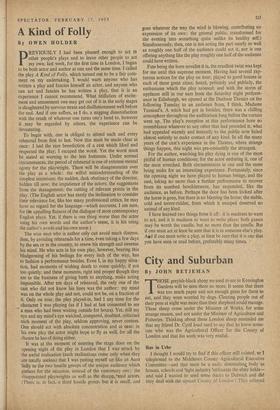City and Suburban
me to the Surrey CC, but before admitting defeat I telephoned to the Estate Office of Dulwich College, which used to own a farm there, and said I wanted to send some sheep to Bermondsey. Did they refer their agricultural matters to any- one on the LCC? They said they made ^their grazing returns to the Surrey CC. So then I approached the LCC itself and said I wanted to send a cow to someone who had a large garden in Canonbury and who was their officer who would deal with inspecting it and registering, if necessary, any milk returns? The switchboard was most obliging and after trying Parks and considering 'Horticulture, I think I got on to Public Health, who courteously referred me to the Health Depart- ment of the Borough of Islington, and there I have let the matter rest, as must also the Agricultural Officer of the LCC.
Preserver and Pioneer In all the notices of Mr. R. H. Roberts, the Birmingham business man who died last week, I have seen no reference to his work as a pioneer in English catering. It was his imagina- tion and enterprise which made the Bay Tree Hotel at Burford in Oxfordshire and its adjuncts a sort of cordon bleu of the best type of English country-house cooking. R. Ft Roberts was Birmingham through and through, educated at King Edward's School and Birmingham University and with that sense of public service which goes with that largely Nonconformist city. But what made him a rare type among business men today was that he upheld the provincial tradition of interest in the arts. Belfast, Birmingham and Glasgow, you will remember, patronised the Pre-Raphaelites. Manchester patronises music and is said to have the most intelligent theatre audiences. With the provinces too go social experiments like Bournville at Birmingham and Reckitts Garden Village at Hull. Mr. Roberts, I remember, gave sage advice to the Oxford Preserva- tion Trust. He liked finding what was best in England and by his vigour and imagination keeping it alive.
NHS—Before and After I have been luxuriating in an eleven-day bout of influenza and most excellently looked after under the National Health Service. If there are still any people who deplore the Health Service, they may like to hear a story my country doctor told me. He came to me after visiting an old lady of over eighty in a near-by almshouse. As a child she had fallen down some stone steps and broken both the fibula and tibia of her leg. Her parents, though they lived only a hundred yards from the surgery, were too poor to send for the doctor. They put her to bed in a corner of the room with poultices of tea leaves on her leg for nine months. When she cried with pain, her mother came over and hit her. She rose from bed with her leg deformed and has remained a cripple for the rest of her life.
Aldwych—Modern Style I have always been told that Norman Shaw was called in to make the exterior of the doomed Gaiety Theatre, on the corner of Aldwych, more attractive, and that he thought of those broad bands of green stone which weld the building together horizontally. It looks too as though his influence inspired the cheerful architecture of Marconi House next door. What surprises me about the new building, illustrated in The Times last week, which is to be erected on its site is not its style, but its shape. The style is old-fashioned `modern' standing on stilts, two up-ended packing cases at right angles to one another and admirably expressing the age. They do not look as though they were built for eternity, like architecture used to be, We are less sure of ourselves today.











































 Previous page
Previous page